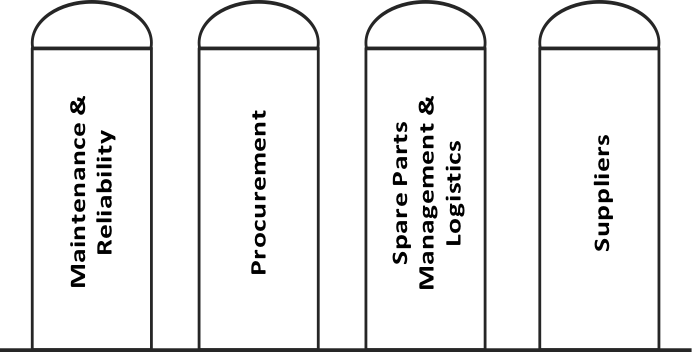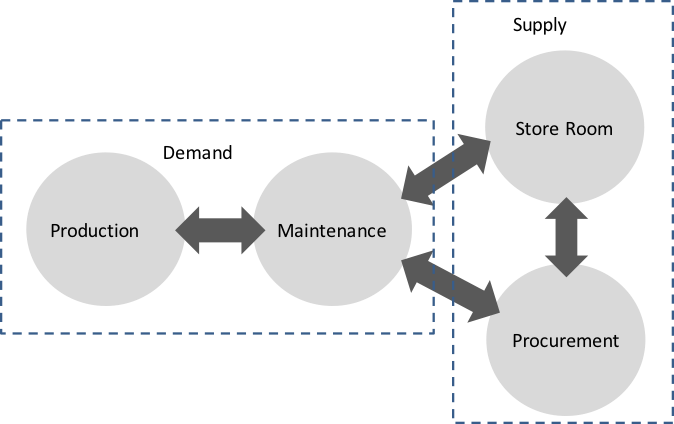The information and know-how required to effectively manage a company’s spare parts operations does not reside in just one function
7. Transforming Your Spare Parts Operations Requires C-Level Engagement, Not Just Support
 If you have read the preceding six parts to this series the reason why transformation requires C-level engagement (and not just support) should be obvious. I can sum this up in just three words: span of control.
If you have read the preceding six parts to this series the reason why transformation requires C-level engagement (and not just support) should be obvious. I can sum this up in just three words: span of control.
What this series of articles has demonstrated is that the information and know-how required to effectively manage a company’s spare parts inventory does not reside in just one function.
The key functions that influence spare parts outcomes typically operate independently, with little incentive to coordinate activities in a way that improves overall business results.
This is classically known as ‘Functional Silos’ because each function reports through to a different senior manager, has their own key performance indicators that drive their own effectiveness and efficiency, and effectively operates as though the other functions are parts of different organizations.
Spare Parts Operations Do Not Function Independently
The problem with this is that these functions do not actually operate independently. There are significant linkages between each function, involving both the flow of information and the physical movement of parts.
The figure below shows a simplified version of the linkages between the internal company functions that influence spare parts inventory.
This figure divides the functions into two management activities, based on their involvement in either supply of spare parts or demand for spare parts.
This supply/demand segmentation helps clarify the role of each function in an overall model of operations planning. What is clear is that, at a minimum, they are each inter-dependent because they rely on each other to be able to achieve their own goals and to be able to contribute to the overall goals of the organization.

What Happens When One Function Has Greater Influence?
But what happens when one function has greater influence than another? Typically, this results in the approach to spare parts management being skewed towards their particular functional expertise.
For example, when procurement has greatest influence the focus is on purchasing and pricing issues. When maintenance has greatest influence the focus is on holding lots of ‘just in case’ inventory.
When the storeroom has greatest influence the focus will be on administrative controls. Like any multi-factorial management situation, a strong focus on any one aspect results in a sub-optimal result.
(Over the years I have seen each of these scenarios in action. Perhaps you can recognize this influence in your own company.)
This is why transforming your spare parts operations requires C-level engagement, not just support. There needs to be oversight that takes into account the big picture and that understands the impact that effective spare parts inventory management has on C-level issues.
Over the course of this series, Phillip Slater has provided articles on spare parts operations and inventory management issues relating to the agenda of interest to senior managers and CFOs.
The issues discussed are not operational but rather they relate to the business impact of spare parts inventory management decisions, which is usually under-estimated by senior management.
The motivation here was that too often mid-level managers are keen to improve spare parts management outcomes (as they should) but their efforts are actually hampered by more senior managers who do not really understand the nuances of spare parts operations management or the influence that spare parts management can have on C-level issues.
Conversely, sometimes senior managers will seek improvement in spare parts related outcomes but they rely entirely on the advice of mid-level managers who don’t understand the nuances of spare parts management and so the company fails to achieve all that it could. They certainly wouldn’t do that with an issue such as safety.
This series has been written to educate senior managers and CFOs so that their companies might achieve the results of which they are capable.
This series of articles has so far addressed the following issues:
- Most of what you have learned about inventory management does not apply to spare parts
- You will need to hold items that will not move often (if at all)
- Excess spare parts inventory is a symptom of other problems
- Spare parts management is fundamental to achieving your business strategy
- Your profit relies on the day-to-day decisions made on spare parts holdings
- How 36% of working capital spent on spare parts is wasted
You might be interested in going to the start of this series Part 1: Most of What You Have Learned About Inventory Management Does Not Apply to Spare Parts.
For information on our spare parts management online training please visit our Pro Level page.
Author: Phillip Slater